The Ha Giang Loop is one of the most impressive routes in Vietnam, offering breathtaking scenery of karst mountains, rice terraces, and river valleys. This loop, located in the Ha Giang province near the Chinese border, can be completed in three to five days. Whether you choose to ride a motorbike, travel by car, or ride on the back of a motorbike with a guide, the awe-inspiring landscapes and cultural experiences make it a must-do adventure.
- What it the Ha Giang Loop?
- How to get to Ha Giang
- Getting around Ha Giang
- Best time to do the Ha Giang loop
- Itinerary Ha Giang Loop
- Highlights of the Ha Giang loop
- Recommended accommodation in Ha Giang
- Eating & restaurants
- Ha Giang loop tips
What it the Ha Giang Loop?
The Ha Giang Loop is one of the best experiences in Vietnam, combining stunning mountain scenery with rich ethnic cultures. This route offers mountain passes, viewpoints, rice fields, and roads where you’ll want to stop at every turn to take photos. As you travel, you’ll encounter local villages, traditional houses, and colorful ethnic markets, making it feel like stepping back in time.

The loop starts and ends in Ha Giang City, taking you through the province’s highlights. While it can be completed in a minimum of three days, extending the trip to five days or longer allows for trekking and more off-the-beaten-track exploration. Although most popular by motorbike—either riding yourself or with a guide—the same route can also be done by car. Accommodations range from local homestays with ethnic families to luxury lodges, providing diverse options for every night’s stay.

Despite the increasing popularity, only a few spots along the loop get crowded, especially on weekends. Most of the route remains peaceful and serene, offering an authentic experience of Vietnam’s natural beauty and cultural richness.
How to get to Ha Giang
The Ha Giang Loop begins and ends in Ha Giang City, which shares the same name as the province. The most convenient way to reach Ha Giang City is from Hanoi, regardless of your starting point in Vietnam, as there is only one major highway leading there. There are no train stations or airports in Ha Giang.
The journey from Hanoi to Ha Giang takes roughly six hours and can be done by:
- Sleeper bus, which travels at night, saving daytime for exploring Ha Giang.
- Limousine buses, which operate during the day.
- Private car with a driver, offering flexibility and comfort.
From Hanoi To Ha Giang by bus
There are a few bus companies that travel between Hanoi and Ha Giang City. The buses depart daily, and the journey takes 6 to 8 hours depending on the bus providers. You can choose between a normal sleeper bus or a luxury VIP bus, which offers more comfort and leg space.


The sleeper buses leave in the evening between 8 PM and 11 PM, arriving in Ha Giang City very early in the morning, from 3 AM to 5 AM. Some bus companies allow you to sleep on the bus until sunrise, but it might be wise to arrange a few extra hours of sleep at a hostel, hotel, or homestay before starting the Ha Giang Loop. Some bus companies include:
- Group tour
- Quang Giang
- Express Ha Giang
From Hanoi To Ha Giang by limousine van
For a little more, you can travel by a comfortable limo-van. While some people find it difficult to sleep on sleeper buses and have safety concerns, limousine buses are a great alternative.

These buses offer VIP-like seats and travel during the day. If you start early in the morning, you will arrive in Ha Giang around 1 PM. You can then find a nice place to stay, like Thon Tha Village, to relax for the rest of the day and start the loop the next morning. This option is more comfortable and safer, although it costs you an extra day.
Arranging your transfers to Ha Giang
Option 1: As part of your tour
Most people don’t arrange bus tickets themselves but get them as part of a complete tour. If you are doing the loop by car, on the back of a motorbike with a guide, or driving yourself in a group tour, the operator normally helps you arrange all transfers to and from Ha Giang. They ensure the bus picks you up at the right place in Hanoi and drops you off at your starting point in Ha Giang, making traveling convenient.
Unique Ha Giang experiences by Local Vietnam
If you are interested in this amazing experience, Local Vietnam offers the Ha Giang Loop by car, on the back of a motorbike, or self-drive (only if you have a valid motorbike license). We arrange transfers from Hanoi to Ha Giang and back, all accommodations, transportation in Ha Giang, and meals.
Option 2: Booking a bus ticket
If you prefer to do everything yourself—traveling to Ha Giang, renting a motorbike, and driving the loop independently—these are your options:
Online Booking Sites:
Offline agents:
Any travel agent in Hanoi can book bus tickets from Hanoi to Ha Giang for you
Getting around Ha Giang
From Ha Giang City, you begin the infamous Ha Giang Loop. You have various options to choose from depending on the level of comfort and adventure you desire. Whether you prefer the thrill of driving a motorbike, the convenience of riding on the back of one, or the comfort of traveling by car, each option will take you around the same route and provide an amazing experience.
1. Driving a motorbike yourself

Driving yourself provides the ultimate sense of freedom and adventure. However, Vietnam, particularly the mountainous regions of Ha Giang, is not ideal for beginners. This option is recommended only for those with a valid motorbike license and International Driving Permit (IDP) and sufficient riding experience. If you meet these criteria, it will be one of the most memorable motorbike trips you can undertake.
Even if you drive yourself, you can still join a tour. These tours allow you to ride with a group and include a guide, eliminating the need to navigate on your own. This option is popular among backpackers who enjoy the combination of adventure and the social aspect of traveling in a group. However, you will need to adhere to the group’s pace, which might limit your time at certain spots.
2. On the back of a motorbike (Most recommended)

Riding on the back of a motorbike retains the sense of freedom and adventure while significantly increasing safety, especially for those without experience or a motorbike license. Most motorbike guides are locals who have lived in Ha Giang all their lives and know every turn and crack in the road. They are trained to drive at a gentle speed, ensuring that passengers feel safe and have time to take photos. Additionally, they know all the right places to stop and hidden gems along the way.
TIP! Motorbike tour
Are you excited to go on the back of a motorbike with a highly experience guide around Ha Giang? Check out our unique Ha Giang loop tour.
3. By car with driver

Traveling by car follows the same route as the motorbike tours. While it may lack the adventurous feel and the authentic experience of traveling like the locals, it offers several advantages. You still see the same breathtaking scenery and stop at the same places, but with much more comfort. A car provides protection from rain, heat, and cold weather and makes it easier to bring luggage. This option is ideal for those who prioritize comfort and convenience over the rugged adventure of a motorbike.
Unique Ha Giang experiences by Local Vietnam
If you are interested in this amazing experience, Local Vietnam offers the Ha Giang Loop by car, on the back of a motorbike, or self-drive (only if you have a valid motorbike license). We arrange transfers from Hanoi to Ha Giang and back, all accommodations, transportation in Ha Giang, and meals.
Best time to do the Ha Giang loop
Ha Giang can be visited all year round, with its scenery always looking stunning. However, the absolute best time to do the Ha Giang Loop are the months of September, October, November, March, and April. These months typically avoid heavy rain and extreme temperatures, offering a perfect balance.
What to expect per season in Ha giang
Winter (December – February)
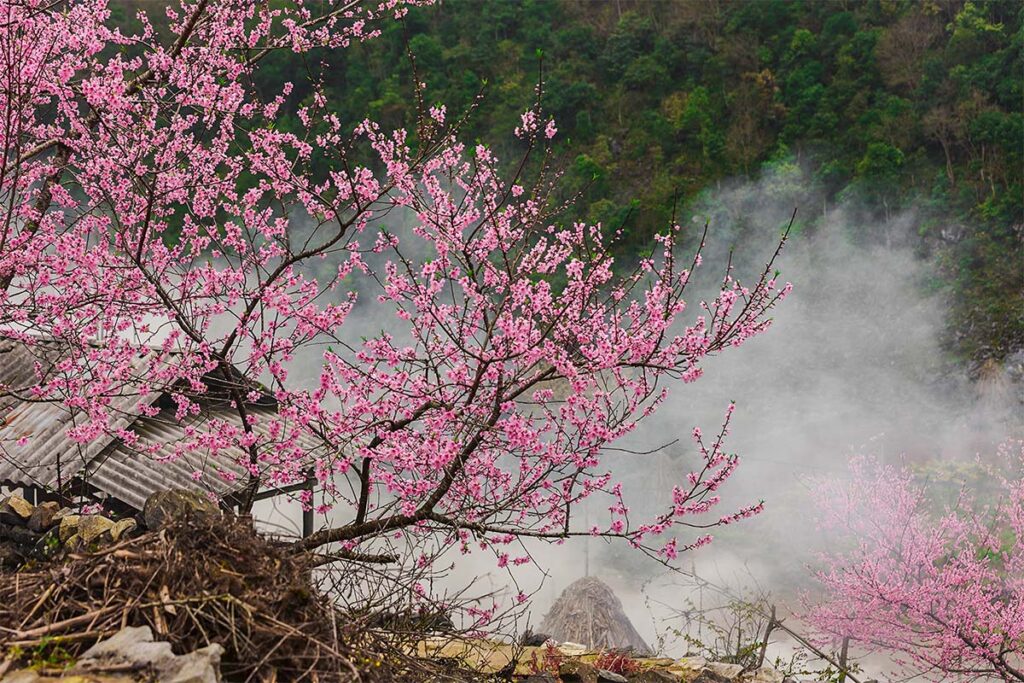
These months fall within the dry season, so there’s hardly any rain, which is a great advantage. However, it can get quite cold, with temperatures ranging from 5°C to 15°C (41°F to 59°F). The cold months also bring a higher chance of clouds hanging in the mountains, which can either create amazing mystical views or block the views completely. This season is perfect for cozying up with campfires, enjoying mystical landscapes, seeing ethnic people prepare for Tet, and witnessing the blossom of peach and plum gardens. However, if you don’t like the cold, consider opting for the car tour or visiting in a different season.
Spring (March – May)

Spring is the best time of the year to visit Ha Giang. The cold of winter disappears, but the heat of summer has yet to arrive, so the temperatures are perfect for outdoor activities, with cool nights ideal for sleep and campfires. The skies are clearer than in previous months, and rainfall is still low, though it increases slightly in May.
Summer (June – August)

Summer means the rainy season, but Ha Giang becomes more green and vibrant. Nature comes alive, and this is the only time of the year to see the rice fields in bloom. There is still plenty of sunshine, often more than during the dry winter months. However, when it rains, it rains hard, which can cause problems in the mountainous region of Ha Giang, including landslides during very heavy rain. Ha Giang is safe to travel in summer, with a lot of sun, but when it rains, seek shelter at a safe spot and travel with local guides who have experience and know the area.
Autumn (September – November)

This is again the best time of year to do the Ha Giang Loop. September is still part of the rainy season, but the worst rains are over. Additionally, if you travel at the beginning of the month, you might see the golden harvest of the rice fields! After September, the rain lessens, and the heat and humidity drop. October and November offer amazing weather, not too hot or cold, with little rain. These months are also the best time to see the buckwheat flowers blooming around the slopes and foothills.
Route & itinerary for the Ha Giang Loop
Even though distances don’t look that far, driving through the mountains takes a lot more time. A 100 km route can easily take more than 3 hours without stopping. To enjoy the most of it, it is recommended to take at least the 4 day Ha Giang loop. In the 4 and 5 day Ha Giang loop there is also time to do some trekking.
3 day itinerary Ha Giang Loop
- Day 1: Ha Giang City (start) – Quan Ba Pass (viewpoint) – Twin Mountains (viewpoint) – Tham Ma Pass (viewpoint) – Chin Khoanh Pass (viewpoint) – Sung La Valley (sighteeing) – Hmong Kings Palace (sighteeing) – Dong Van Old Quarter (sighteeing) – Dong Van (overnight)
- Day 2: Dong Van – Ma Le village (sighteeing) – Lung Cu Flag Tower (viewpoint) – Ma Pi Leng Pass (viewpoint) – Nho Que river (boat tour) – Meo Vac (overnight)
- Day 3: Meo Vac – M shape turn (viewpoint) – Mau Due (rice fields) – Lung Ho (viewpoint) – Ha Giang City
4 day itinerary Ha Giang Loop
- Day 1: Ha Giang City (start) – Quan Ba Pass (viewpoint) – Twin Mountains (viewpoint) – Tham Ma Pass (viewpoint) – Chin Khoanh Pass (viewpoint) – Sung La Valley (sighteeing) – Hmong Kings Palace (sighteeing) – Dong Van Old Quarter – Dong Van (overnight)
- Day 2: Dong Van – Ma Le village (sighteeing) – Lung Cu Flag Tower (viewpoint) – Ma Pi Leng Pass (viewpoint) – Nho Que river (boat tour) – Meo Vac (overnight)
- Day 3: Meo Vac – M shape turn (viewpoint) – Mau Due (rice fields) – Lung Ho (viewpoint) – Du Gia waterfall (swimming) – Du Gia (overnight)
- Day 4: Du Gia – Du Gia rice fields – Ha Giang City
5 day itinerary Ha Giang Loop
- Day 1: Ha Giang City (start) – Minh Tan Stream (Swimming) – Quan Ba Pass (viewpoint)- Lung Khuy Cave (cave exploring) – Lung Tam Village – Yen Minh Pine Forest – Yen Minh (overnight)
- Day 2: Yen Minh – Tham Ma Pass (viewpoint) – Chin Khoanh Pass (viewpoint) – Sung La Valley (sighteeing) – Hmong Kings Palace (sighteeing) – Lo Lo Chai Village (sighteeing) – Lung Cu Flag Tower (viewpoint) – Ma Le village (sighteeing) – Dong Van Old Quarter (sighteeing) – Dong Van (overnight)
- Day 3: Dong Van – Trekking around Dong Van – Ma Pi Leng Pass (viewpoint) – Nho Que river (boat tour) – Meo Vac (overnight)
- Day 4: Meo Vac – M shape turn (viewpoint) – Mau Due (rice fields) – Lung Ho (viewpoint) – Du Gia waterfall (swimming) – Du Gia (overnight)
- Day 5: Du Gia – Du Gia rice fields – Ha Giang City
30 Highlights of the Ha Giang loop
The Ha Giang Loop is filled with breathtaking highlights and must-see sights along the route. In this section, we have listed the best things to see from the start of the loop to the end, not by their importance but by their order along the journey. This way, you can follow this list and ensure you don’t miss out on anything as you travel. To fully experience all 30 highlights, it is recommended to take more than 3 days, ideally 4 to 5 days.
Sights and highlights between Ha Giang and Dong Van
1. Ha Giang City
Ha Giang City is both the start and end of the loop. While it may not be a major highlight due to its lack of attractions and atmosphere, it serves as the gateway to the adventure ahead. If you have some extra time, consider exploring the area around the city.

A short 10 to 20 minute drive brings you to stunning sceneries. Thon Tha Village is a great area where local ethnic Tay people live among green rice fields.

Just 6 km from Ha Giang is the Number 6 Waterfall, named simply after its distance from Ha Giang.
2. Minh Tan Stream
Located approximately 50 km from Ha Giang City on National Highway 4C, Minh Tan Stream is a popular spot for cooling off and taking a dip during hot days for mostly people that are on the end of the Ha Giang Loop, just before arriving back in the city. This small stream offers a refreshing break in the midst of your journey.
3. Bac Sum Pass

Bac Sum Pass is the first pass on the Ha Giang Loop, providing nice views. While not as spectacular as what awaits you further along the route, it offers a gentle introduction to the stunning landscapes of Ha Giang and sets the tone for the adventure ahead.
4. Quan Ba Pass (Heaven’s Gate)

From Quan Ba Pass, also called Heaven’s Gate, the scenery starts to get better and better. There’s a coffee shop at the top of the pass where you can enjoy a refreshing drink while taking in the beautiful views. This stop is perfect for a relaxing break and a chance to appreciate the surrounding landscape.
5. Twin Mountains Viewpoint

The Twin Mountains, also called Fairy Bosom, are two almost identical mountains situated next to each other. Halfway down from Quan Ba Pass, there is a viewpoint to see these mountains. Park your vehicle at the designated spot on your left and climb the stairs to the viewpoint. From here, you can marvel at the twin peaks rising majestically from the lush green valley below.
From here you continue your way to Quan Ba town; a good town to find a place for lunch.
6. Nam Dam Village & waterfall

Venture off the main route of the Ha Giang Loop to enter Nam Dam Village, where you can experience the traditional way of life of the ethnic people. There are homestays available for an overnight stay.

The village also has a hidden gem, Nai Nam Dam Waterfall, where you can take a refreshing shower, especially on a hot day.
7. Lung Khuy Cave
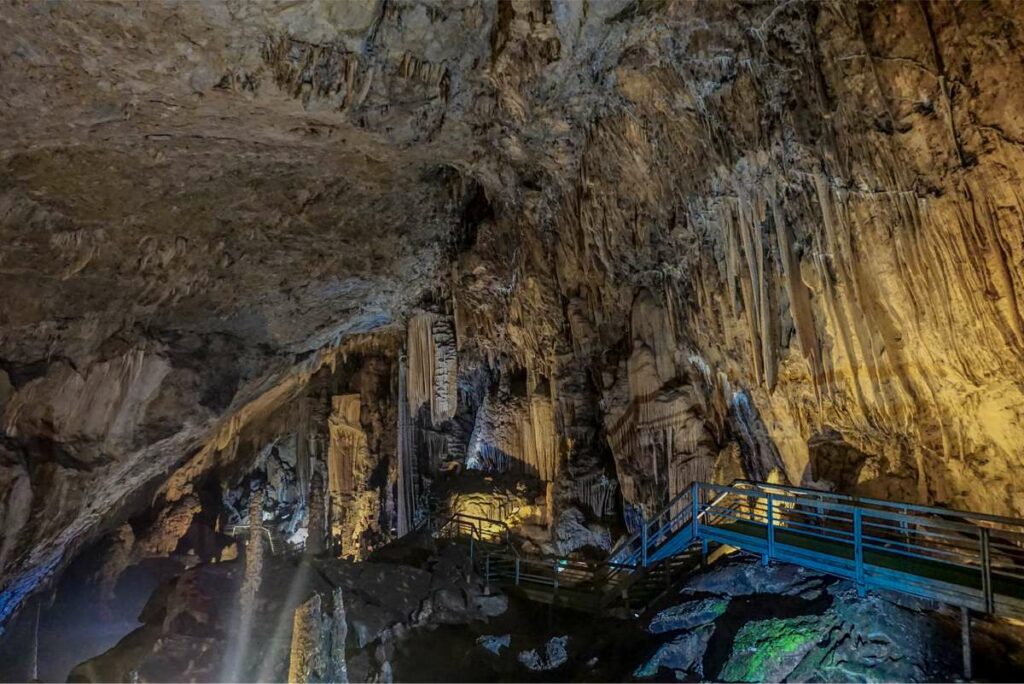
Before you head from Quan Ba town to Yen Minh, you can make a small detour to Lung Khuy Cave. A winding road up through impressive mountains brings you to Lung Khuy Cave. The road to the cave is already worth the trip. Inside the cave you will find beautiful stalagmites and stalactites. It is easy to explore as a path has been laid through the cave. Entrance fee to the cave is 50,000 VND.
8. Lung Tam Village

Lung Tam Village is a serene weaving village inhabited by the H’mong ethnic people. The village is known for its traditional hemp weaving and dyeing techniques. You can visit weaving workshops and see how traditional textiles are made. The village is also very picturesque, with a river running through it, creating a super peaceful atmosphere. Slightly off the main route of the loop, it’s a lovely place to visit if you have the time.
9. Yen Minh Pine Forest

As you continue your journey along the Ha Giang Loop, you’ll encounter a sign offering two routes to Yen Minh Town. The shorter route goes through the mountains, while the longer route leads to the Yen Minh Pine Forest. Opting for the longer road takes you to this refreshing forest, where you can take a break amidst the shade of towering trees and enjoy the serene atmosphere.
10. Tham Ma Pass
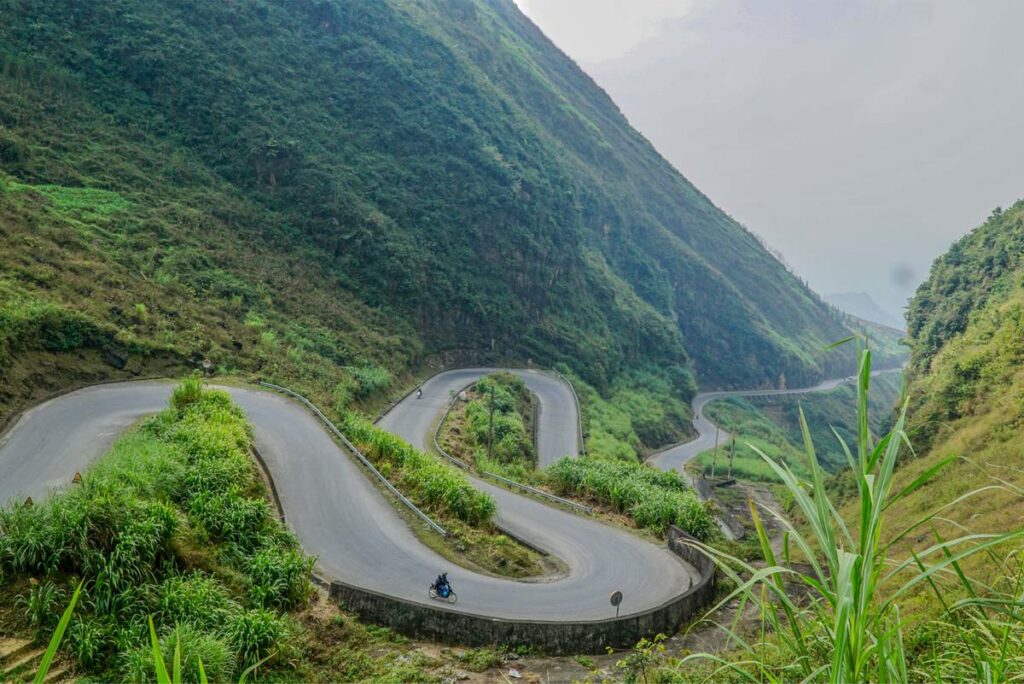
The route from Yen Minh to Sa Phin brings you over the Tham Ma Pass. This mountain pass is one of the impressive mountain passes in UNESCO Dong Van Karst Plateau Geopark. A winding road up brings you to a small parking area were you can take photos of this iconic S-shaped pass.
11. Chin Khoanh Pass

Chin Khoanh Pass, also known as the Nine Turns Pass, consists of nine sharp turns. While there aren’t many designated viewpoints here, you can stop higher up in the pass to take in the amazing views of the winding road below and the green valley with villages nestled within it.
12. Sung La Valley
Continuing the road from Chin Khoanh Pass brings you in Sung La Valley. This valley is known for having the most beautiful highland commune in the whole Dong Van Plateau. Especial during the flower season the valley is very stunning and colourful. For this reason it is also called “Flower of the Plateau”.

Lung Cam Village in this valley is very famous, because of Pao’s House. This traditional house of the Hmong minority, is used in the movie The Story of Pao, that every Vietnamese knows. You can visit this house to see how an old traditional minority house looks like from the inside.
13. Pho Bang Old Town

For a unique off-the-beaten-track experience, venture towards Pho Bang Village. Here, you’ll discover beautiful ethnic houses nestled amidst stunning scenery. While there might not be many other attractions in the area, the tranquil ambiance and picturesque surroundings make it a worthwhile stop on your journey.
14. Hmong Kings Palace

The Hmong Kings Palace in Sa Phin, is a built in Chinese architectural style, with mainly wood, stone and terracotta tiles. It is one of the oldest buildings in the region, used to protect the Vuong family from attacks. This family became rich by dealing goods, especially opium.
15. Sa Phin market

Another highlight in Sa Phin is the Sa Phin market. Here local minorities out the region come to sell and buy goods, but also to socialise with old friends and to make new friends. It is also one of the four backwards markets in Ha Giang. This means for example, this week the market is on a Sunday, next week it is held on a Saturday and the week after on a Friday.
16. Dong Van Old Quarter

Dong Van is one of the main towns in Ha Giang. Many travelers choose to stay here for a night during their Ha Giang loop. The historical part of town is called Dong Van Old Quarter, with a preserved architecture dating back hundreds of years. Especially at night it can be very cozy to sit here and enjoy the atmosphere. Behind the Old Quarter is on old French Fort on top of a mountain, with views over the city and mountains.
17. Dong Van Market

The Dong Van market is one of the many other markets in Ha Giang. But they never get bored visiting. The one in Dong Van is one of the biggest markets. here you can see hundreds of ethnic people with the most bright clothes. Some people are getting a hair cut right at the market, next to trader who is selling is buffalo. The market is held once a week on Sunday.
Sights and highlights between Dong Van and Lung Cu
18. Khe Lia Panorama

The entire road from Dong Van to Lung Cu offers some of the best mountain scenery on the loop. The mountains are huge and rugged, with several small villages to visit along the way. You might want to stop at many places to take photos or enjoy the view. One marked viewpoint, Khe Lia Panorama, is about halfway along this route. It has a small parking area and stairs that lead you higher up for a 360-degree view of the stunning landscape.
19. Ma Le Village

Ma Le Village is another ethnic village with traditional houses made of yellow clay and wood. The village has an old, traditional feel, offering a step back in time. It’s a small village that can be explored in about 20 minutes, making it a perfect stop to stretch your legs on the road from Dong Van to Lung Cu.
20. Lung Cu Flag Tower

The Lung Cu Flag tower is a very high structure on top of a hill. The huge flag points out that this is the most northern point of Vietnam. From the top of the hill you can see both Vietnam and China.
21. Lo Lo Chai Village

Lo Lo Chai Village is located near Lung Cu and is home to the Lo Lo ethnic group. The villagers wear vibrant traditional clothes, and their houses are beautifully constructed with bright yellow clay and wood. There are several homestays run by ethnic families, offering a unique opportunity to gain insight into their local culture.
Sights and highlights between Dong Van and Meo Vac
22. Ma Pi Leng Pass

The Ma Pi Leng Pass is probably the most impressive part of road of the Ha Giang loop. It lies between the towns of Dong Van and Meo Vac. This epic road is directly carved into the side of the mountain, with hundreds of meter high steep cliffs. You can park your motorbike on the top to take a walking path along the ridge to make some amazing photos.
23. Ma Pi Leng Sky Walk
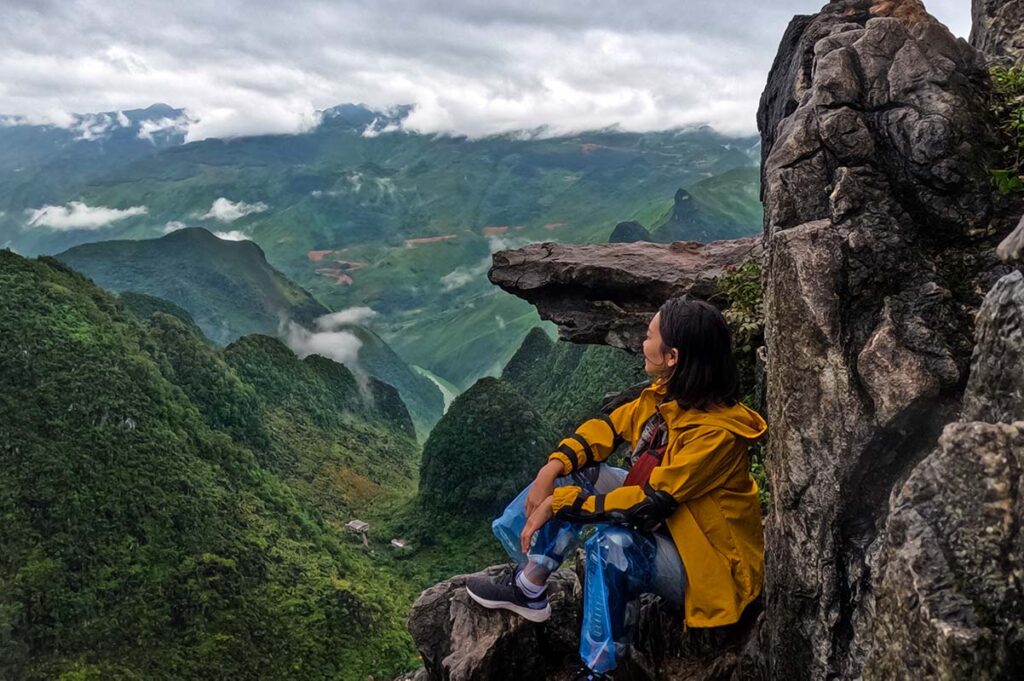
At the Happiness Road Museum on Ma Pi Leng Pass, there’s a side road that goes up, officially allowed for walking only. This road ascends higher than the main road, providing epic views of the main road, the river far below, and the surrounding mountains. There’s also a famous spot with a rock overhanging the pass, perfect for photos. Most people stop here, but you can follow the road further for more secluded views.
24. Nho Que river
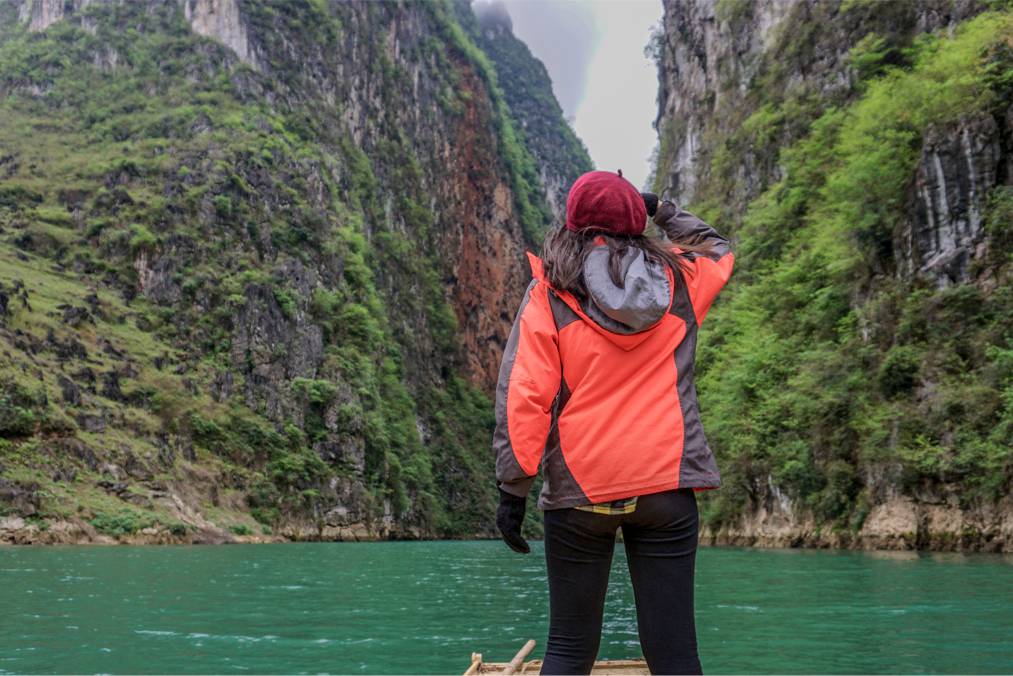
Nho Que river is part of the magnificent view from the Ma Pi Leng Pass. But there are also a few hidden roads that bring you all the way down the river. From here you can take a one hour boat trip between the high cliffs of the pass.
25. Meo Vac Market

If you are lucky and be in Meo Vac on Sunday, you are up for a threat. The Meo Vac market is the biggest minority market in Ha Giang and one of the most impressive markets in Vietnam. It starts very early in the morning and get less busy at around 11:00 PM. There is a part with live stock, were people bring their animals, not just to sell, but also to show off. Outside in the streets are a lot of stall selling about anything, from local products to even cell phones. The indoor market is used as a large food market, including fresh food and small stall were they prepare the food on an open fire.
Sights and highlights between Meo Vac and Ha Giang
26. The road from Meo Vac to Mau Due

The road from Meo Van all the way to Du Gia, via Mau Due is stunning. In fact, this road isn’t anything less than the famous Ma Pi Leng pass. Via zigzagging roads through the mountains you pass through countless of minority villages. You will see lots of colorful ethnic people on the roads and children high fiving you on the way, while having impressive mountains all around you.

The M-Shaped Viewpoint is a great short stop along the road from Meo Vac to Mau Due. From this viewpoint, you can see a road winding up a mountain in the shape of an ‘M.’ It’s a unique sight and a popular spot for photography.
27. Mau Due rice fields
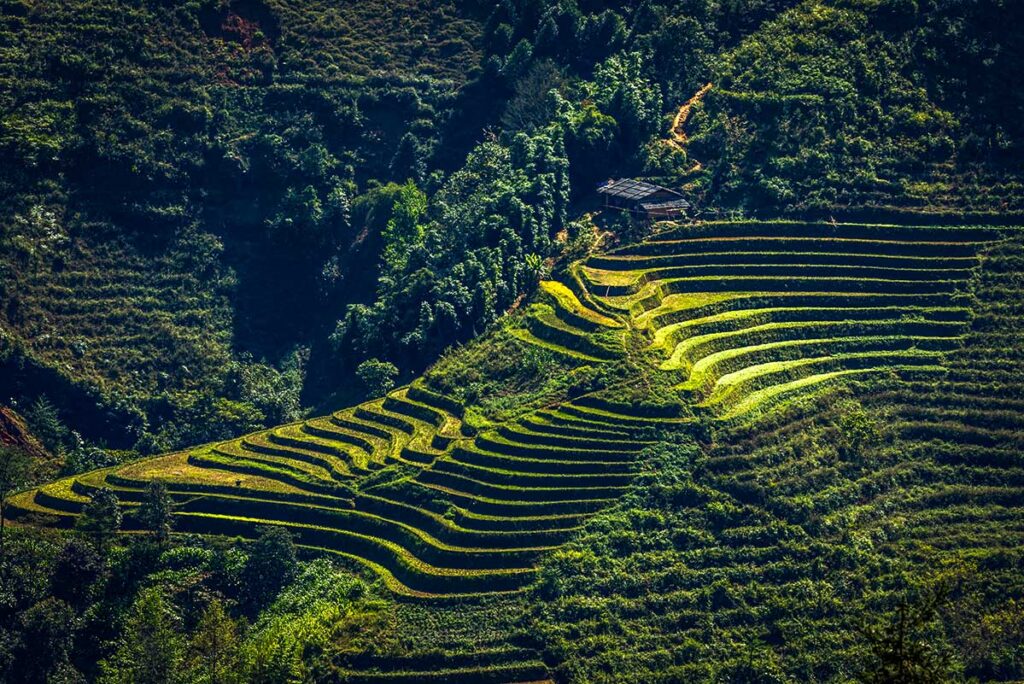
From Meo vac to Du Gia brings you through Mau Due, a road to one of the most impressive landscapes of the Ha Giang loop. Authentic and non touristic road between the amazing mountains and rice-field make Mau Due so special and unique. There are also some hidden waterfalls and rivers in this area, but it takes more then an hour to get to from the main road.
28. Ruins of French fort

Continuing from Mau Due, you’ll encounter an extraordinary road leading up a seemingly endless pass over jagged limestone peaks. Along the way, you can spot several roadside cafes that take advantage of the views. Stop to explore the remains of a centenarian French fort, presumably built around the same time as the fortress in Dong Van. From the fortress ruins, you have amazing views of the surrounding landscape.
29. Lung Ho Viewpoint

Lung Ho Viewpoint is unique for its view of conical-shaped mountains standing next to and behind each other, creating a stunning, shadow-like effect. There’s a coffee shop along the Lung Ho Pass where you can take a break and enjoy the view before continuing your journey.
30. Du Gia Commune

Du Gia Commune is known for its peaceful Tay villages and different scenery, with more rice fields compared to other parts of the loop. The Tay minority people live here in stilt houses, and those doing the loop in four days or longer often stay overnight in one of these stilt homestays.

One of the most popular sights here is the Du Gia Waterfall. Many travelers visit this spot, especially on hot days, to jump from the waterfall into the natural pool or simply swim and cool off.
Recommended accommodation in Ha Giang
Hotels & homestays in Ha Giang City
- Ha Giang Historic Hotel: Best hotel in town. Great location, nice garden, clean rooms and tasty family diner.
- Ha Giang 1 Hostel: Rated as best hostel in Ha Gaing City. Nice staff and great atmosphere.
- Ha Giang Riverside Hostel: Rooms are okay, but location is great along the river and close to the bus stop.
Ha Giang City is not the most atmospheric town to stay. As an alternative, you could also stay just outside the city in a local minority village. The best village outside the city for a local experience is Thon Tha.
Hotels & homestays in Yen Minh
- Homestay BongBang: Best place to stay in Yen Minh. Great soft beds, good atmosphere with family dinner and campfire at night. Staff speaks English.
- Hà Anh Homestay: A nice family dinner and the hostel has a good social vibe. The staff is very friendly and helpful.
Hotels & homestays in Lung Cu
- Sister’s House: The rooms of this homestay are very basic, but there is a great common area with pool table. Also the hosts are very friendly. It is the best place to stay in Lung Cu.
Hotels & homestays in Dong Van
- Green Karst Hostel & Bar: Clean and comfortable, close to restaurants and bars. All you need after a long day’s ride.
- Hoang Ngoc Hotel: One of the better hotels in Dong Van. Room are clean and tidy. Located in the centre of the town close to restaurants.
- Triệu Nghị homestay: A favorite for many backpackers doing the Ha Giang loop. Friendly hosts and great faimly dinner.
- Lam Tung Hotel: Very descent hotel right in the center of town, with nice rooms.
- Binh Minh Hostel: Located in town. Nice big room with clean bathroom. Perfect for an overnight stop on the loop. Plenty of food options nearby.
Hotels & homestays in Meo Vac
- Little Yen’s Homestay: One of the highest rated homestays on the loop. Staff speaks good English and great atmoshpere.
- Ong Vang Meo Vac Hotel: Nice location, queit and relaxing. Rooms are small but clean.
- Va’s Homestay Meo Vac: A nice homestay with a very friendly family who loves to cook for you.
Hotels & homestays in Du Gia
- Du Gia homestay: The best accommodation in the village. Great athmoshere, perfect location with great views. Dorm rooms are very basic, bathrooms look nice. Family dinner is highly recommended.
- Backpacker Garden Homestay: A nice homestay runned by a very friendly family. Nice bungalows in the garden of the homestay.
Eating & restaurants
The restaurants in Ha Giang are very local. Don’t expect anything fancy and there is no western food served any where. Usually you eat both breakfast and dinner at your homestay. Breakfast is often either noodles or bread (banh mi). Dinner at homestays is eaten together with the family and other guest. These family dinners are a great local experience, were you will be most likely asked to join them to drink local rice wine (happy water) with them.
Lunch you have to get at local restaurants along the road. Try to plan this wisely, as some parts are just mountains and countryside, without any restaurant close by.
Ha Giang loop tips
Driving in bad weather
In the mountains, it is hard to predict the weather. If you are doing the Ha Giang Loop in 4 or 5 days, you have enough time each day to drive to your next destination. If you wake up in the morning to heavy rain or thick fog, wait until it clears or lessens before starting. Always be careful on the road, especially after rain.
Carry cash as ATMs are scarce
ATMs are rare along the Ha Giang Loop, so make sure to carry enough cash for your journey, including money for fuel, food, and accommodation.
Download Offline Maps
Internet access can be unreliable in the mountains, so download offline maps to ensure you can navigate without needing a signal.
Bring a portable phone charger
With long days on the road and limited access to electricity, a portable phone charger is essential to keep your devices powered.
Wear sturdy, comfortable footwear
Good footwear is crucial for navigating rocky terrain, whether you are trekking or stopping to explore villages along the route.
Respect local customs and traditions
The ethnic people in Ha Giang have unique customs and traditions. Always ask for permission before taking photos and show respect for their culture and way of life.
Leave bulky luggage behind
Leave bulky luggage, such as a big suitcase, behind at your hotel in Hanoi or with your operator in Ha Giang City. This allows you to travel lighter and more comfortably on the loop.
Small Backpack for Essentials
Carry a small backpack that fits your camera, money, and rain jacket. Your main luggage will be strapped to the motorbike, often wrapped in a rain cover, making it difficult to access during the day. A small backpack ensures you have your essentials handy.
Clothing Tips
Pack layers to adapt to changing weather conditions in the mountains. The weather can vary greatly: it can be cold at higher altitudes and hot in the valleys, with rain on one side of a mountain and dry conditions on the other. Bring thin, breathable layers and a waterproof, windproof jacket so you can quickly and easily adjust to the changing weather.
Combining Ha Giang with Cao Bang and the Ban Gioc Waterfall
Consider combining your Ha Giang trip with a visit to Cao Bang and the Ban Gioc Waterfall. Instead of completing the full loop, go from Meo Vac to Cao Bang. This route offers unexplored areas with ethnic villages and stunning mountains, leading to the breathtaking Ban Gioc Waterfall.
Trekking in Ha Giang
While most people explore the loop by motorbike or car, trekking is a fantastic way to experience the region. Trekking takes you off the main loop trail, offering solitude and a break from motorized travel. Options range from short hikes to multi-day treks.
Terraced Rice Fields of Hoang Su Phi
Ha Giang is home to some of the most stunning terraced rice fields in Vietnam, located hours away from the main loop. Hoang Su Phi is a remote area with breathtaking terraces, perfect for those willing to venture off the beaten path to witness these incredible landscapes.







